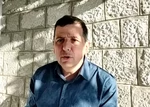
Life in the southern suburbs of Sarajevo is slowly returning to normal on Thursday after the biggest manhunt Bosnia has ever seen ended with the death of a serial killer whom officials described as “schizophrenic” and highly dangerous.
As authorities are closing the case, the public is opening up a discussion on why this mentally disturbed person was not placed into an adequate institution.
The name Edin Gacic and the images of a 42-year-old 180 cm tall man with a slim build and wearing glasses sent over the past nine days shivers down the spines of residents of Tarcin and Podorasac, two villages south of Sarajevo where Gacic first killed a shop owner and a few days later a policeman on duty.
“Since we are talking about a mentally disturbed person, it is difficult to talk about a motive,” AljosaCampara, the Justice Minister of the Federation (FBiH), one of the two semi-autonomous entities within the country, told N1 a day before Gacic was found.

Gacic killed before.
In 1998, he murdered a former member of the wartime unit he was part of, the El-Mujahid, known for their Islamic extremism and brutality.
For this, he was sentenced to 14 years behind bars along with psychiatric treatment.
But while on prison leave in 2002, Gacic went home and committed an even more unexplainable crime.
“The man killed his own mother and then sat in that apartment for two hours (…) and, if I recall correctly, ate Turkish delights and listened to music,” Campara said.
He then left the corpse in the apartment and travelled to Montenegro, where he was eventually arrested and returned to Sarajevo.
The 14 years turned into a nearly 20-year prison sentence which he served mostly in a prison in the central Bosnian city of Zenica.
The Canton Court in Zenica annulled the psychiatric treatment measure in 2003.
Six months before he was supposed to be released, Gacic was transferred to a prison in Bihac to be prepared for integration in society. This is where prison authorities realised they had to warn relevant institutions that Gacic should continue his psychiatric treatment and that there is a possibility that he may repeat the crimes.
“A detailed psychological analysis produced the conclusions that we are talking about a person diagnosed with a combination of schizoid and paranoid disorders,” the head of the Bihac prison Edhem Veladzic said, according to an Anadolu Agency report.
But that is where, it seems, the system failed.
Gacic was simply released in 2017 as the only institution that could have placed him in a mental hospital was the court. But according to the law, judges could do that only if he had committed another crime.
Now the public is asking why and how many other mental patients are freely roaming the country?
“That is not a question I should be answering,” Campara said, but added that, according to reports, prison authorities had no problems with Gacic.
After his release, he would frequently visit the Centre for Social Services in Banja Luka. The administration there, however, said he strongly refused to be helped.
He lived in Banja Luka for a short while, worked as a volunteer in an NGO, went back to his family home and then began selling off his family belongings.
“The system did everything according to procedures and nobody can keep him in custody for longer than what was ruled,” the Dean of the Faculty for Criminalistics, Criminology and Security Studies in Sarajevo, Nedzad Korajlic, told N1.
However, in this particular case, “after he was released, police and other services should have paid more attention,” he said.
But Bosnia’s Security Minister, Dragan Mektic, claims that the state was an accomplice in Gacic’s last two murders.
"Because no effective mechanisms were established and because of our heavy fragmentation and the lack of common functionality, people with mental illnesses and aggressive behaviour are roaming around freely,” he said.
Gacic bought a house in a village near Konjic, south of Sarajevo, and lived there alone without any social connections.
On February 4, he entered the local shop and simply killed the owner Saud Sultanic.
Gacic left the shop and the village and disappeared into the forest for the next nine days.
As police were searching abandoned houses and forests, Gacic appeared in the evening of February 9 at the gate of a police training facility in Suhodol, near the suburb of Tarcin, and killed the police officer guarding the building.
The search team grew the next day to 1,200 men who were combing the area while helicopters and drones with thermal cameras joined the manhunt. Hunters also offered to join.
“We are searching abandoned houses and weekend houses,” Sarajevo Canton Police Commissioner Mevludin Halilovic told N1 on Monday, a day before Gacic’s death.
But he warned people not to act alomne, as the killer is armed and unreasonable.
Authorities said a tip that would lead them to Gacic’s arrest would be rewarded with 50,000 KM.
Now, a highway maintenance worker claims he was the one who saw Gacic walking through the forest and alarmed authorities who eventually found him hiding in a self-made shelter he constructed in the forest from branches.
Authorities surrounded the area on Tuesday and urged Gacic to surrender.
He refused. A shootout ensued.
An officer got slightly injured. Gacic was dead.
Police officers who attended the funeral of their murdered colleague from Suhodol calculated that they were lowering the coffin at the time Gacic was passing away.
Kakvo je tvoje mišljenje o ovome?
Učestvuj u diskusiji ili pročitaj komentare





 Srbija
Srbija
 Hrvatska
Hrvatska
 Slovenija
Slovenija



























































